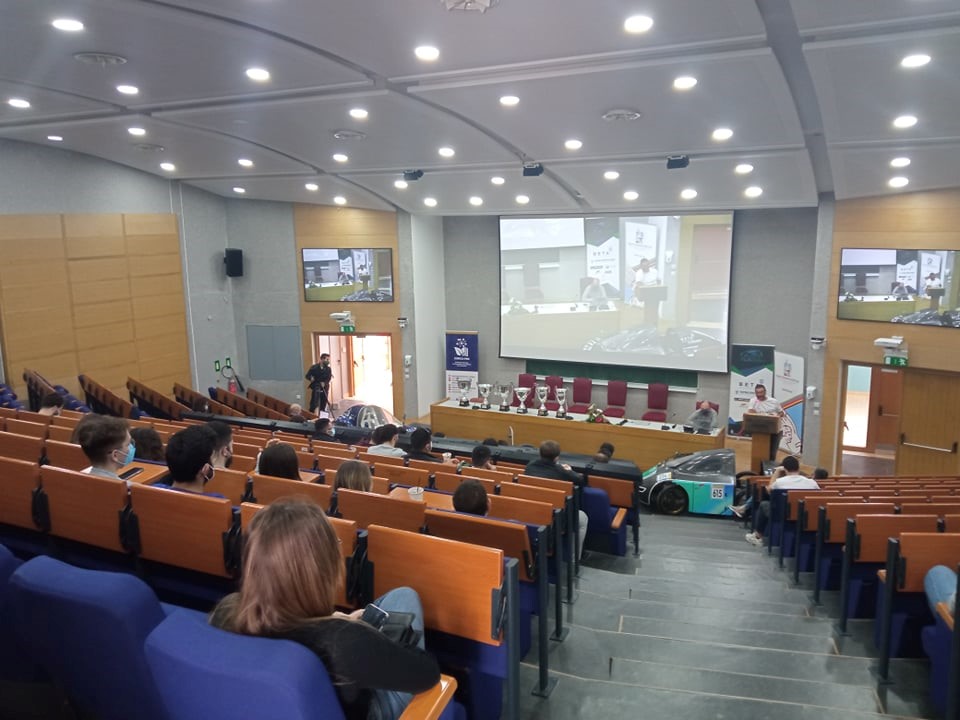The European University on Responsible Consumption and Production/EURECA-PRO organized Open Science Event ΙΙΙ, entitled “Hydrogen-powered vehicles” (Greek: “Υδρογονοκίνητα Οχήματα”). The event was organized by the EURECA-PRO team of the Technical University of Crete (TUC). The Event was free, hybrid, open to public and took place on April 4, 2022, 11:00-13:00 EET, (10:00-12:00 CET), with both a live audience at the Campus of the Technical University of Crete in Chania, Crete, Greece and an on-line audience via zoom.
The full event was presented in Greek and was simultaneously translated into English by a certified interpreter via the zoom interpretation channel.
The event was live streamed on TUC’s official Facebook page and YouTube and a recording of the live stream is available on the TUC YouTube channel.
Open Science Event III on the topic of Hydrogen powered vehicles was presented by the TUCer (Technical University of Crete eco racing) team that develops zero emission, low consumption, hydrogen powered, electric prototype vehicles since 2007. The team consists of volunteers, students and faculty from the Technical University of Crete that share a vision for eco-mobility and a passion for automobile racing.
Abstract
The TUCer team has won several awards at international low consumption competitions.
Presentations about H2 fuel cell stacks, H2 fuel, energy management system, and harvest of regenerative electrical power were made by Dr. Savvas Piperidis, scientific personnel, Dr. Dimitrios Ipsakis, Assistant Professor, School of Production Engineering and Management, Mr Alexandros Sioutis and Mr Emanouil Zachariadis, undergraduate students, School of Electrical and Computer Engineering, Mr Konstantinos Sachinidis, and Mr Christos Stamatopoulos, undergraduate students, School of Production Engineering and Management.
H2 and Fuel Cells
Fuel cells offer a zero-emissions green-technology toward energy production in stationary and vehicular applications. Fuel cells were manifested by W. Grove back in 1870 and used in various applications. Notably in 1950’s, fuel cells were used in space applications in USA (followed then by Japan and Europe). The technology of fuel cells lies on a closed flat system comprising the anode, the electrolyte and the cathode. H2 is fed at the anode and through the active Pt electrode H+ protons and electrons are formed. H+ protons pass through the electrolyte membrane to the cathode and there, oxygen and the electrons (passed through an external circuit) are met towards the production of water (only by-product). In this way, the movement of electrons creates electricity that can be fed for use.
H2 in Vehicles (Toyota Mirai Example)
Toyota Mirai offers one of the 1st (in its category) H2 vehicle that can be purchased today. Based on the provided and open to society specifications the following are reported: a) the fuel cell stack consists of 370 cells that provide a rated power of 114kW (155dinHP) and is located under the driver’s seat, b) the electric motor is on the front compartment of the car and provides a silent operation, c) a battery is used in a similar way as with the conventional cars, d) power conditioning units, humidification subsystems, control & monitoring systems and auxiliary components provide a safe and optimal driving and e) the H2 tank can store up to 5kg (700bar) that provide an autonomy of more than 500km.
H2 Infrastructure and Safety
Currently, H2 is produced from methane steam reforming that is a conventional process that emits high amounts of CO2 to the atmosphere. As an alternative process, water electrolysis that is powered from excess solar/wind energy can offer a long-term sustainable solution. European policies initiated several research programs that aim toward the construction and implementation of GW-based capacities across Europe. Such a project takes place at Western Macedonia under the name White Dragon and have the support of oil & gas companies (among others). Today, there are more than 200 H2 fuel stations in Europe, located mainly in Germany, Austria, UK and Iceland. H2 fuel stations are expensive to build and thus, H2 infrastructure and supply is still in progress. If H2 infrastructure issues are solved, then it is believed that H2 will dominate Europe in terms of vehicular applications (e.g. buses, cars, motorcycles).
H2 Vehicles versus Electric Cars
Clearly, H2 vehicles should not compete electric cars and vice versa, but should be considered as partner solutions towards a green environment.
However, it is important to provide a side-to-side comparison on a few issues:
a) for a distance of 500km an electric car should charge between 2-3 times lasting 30-45min whereas a H2-vehicle requires one single charge of up to 5mins,
b) electric cars are cheaper than H2 vehicles,
c) both electric and H2 cars offer a cheap solution regarding fuel cost per year.
Open Science Event III is directly related with EURECA-PRO Light House Missions, LH4: Clean Energy, LH1: Responsible Material Flows, LH3: Sustainable Materials and Products, LH2: Environment and Water, and LH5: Process Automation and Industry 4.0.
The team’s activities are being supported by the Intelligent Systems and Robotics Laboratory, the Interdepartmental Machine Tools Laboratory, the Circuits, Sensors and Renewable Energy Sources Laboratory and the Digital Fabrication Laboratory of the Technical University of Crete.
Open Science Event III was in compliance with the national and institutional protocol measures against COVID’19



